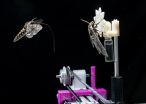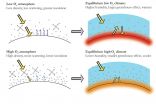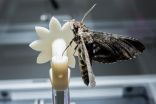(Press-News.org) Nursing home residents with dementia are less likely to be apathetic if they live in an appropriately stimulating environment, according to nursing researchers.
Nearly half of all residents in nursing homes have dementia, according to a 2013 report by the Centers for Disease Control. Apathy is one of the most common neurobehavioral symptoms in dementia, with about 90 percent of older adults with dementia experiencing it. Those with mild dementia will decline more quickly into severe dementia if they also suffer from apathy, making it important to help them stay engaged.
'Persons with dementia who are also apathetic won't be curious about the world around them; they are not motivated to carry out activity nor engage with those around them, in either a positive or a negative way,' said Ying-Ling Jao, assistant professor of nursing, Penn State. 'Apathy has several negative consequences for both the persons with dementia and their caregivers. The individuals' cognitive function will likely decline faster and their caregivers will have more difficulty with their caregiving and are more likely to become depressed.'
Jao observed 40 nursing home residents with dementia by watching video recordings of each taken throughout a typical day. She chose three videos per resident from recordings made during a previous study -- one taken at a mealtime, one during a direct interaction between the resident and staff and one that was randomly selected.
'The purpose of this study was to examine the relationship between environmental characteristics and apathy in long-term care residents with dementia,' said Jao, who reports her results in the current issue of The Gerontologist. 'My interest in apathy was mainly driven by my clinical observations in nursing homes when I was a nurse practitioner student. I remember that no matter which nursing home I visited, I often saw a crowd of residents sitting in the living room or hallway with no interest in the surroundings and no emotional expression.'
Jao looked at five characteristics in particular: environmental stimulation, ambiance, crowding, staff familiarity and light and sounds. Of the five, clear and strong environmental stimulation was the most significantly associated with a lower apathy level in the residents.
'Interestingly, our results showed that clear and strong environmental stimulation is related to lower apathy, while no stimulation or an overwhelming environment with no single clear stimulation is related to higher apathy,' the researchers said.
Clear stimulus is found in an environment without competing background noise, and with a single straightforward stimulus. A good example of this is a therapist leading a music therapy program for residents in an otherwise quiet room.
The strength of the stimulus depends on how intense, persistent, interesting and out of the ordinary it is. Routine activities, such as a regular conversation or meal, are considered moderate stimulation, while a birthday party is considered strong simulation.
'One of the innovative features of this study is that we used the Person-Environment Apathy Rating scale to measure environmental stimulation at an individual level,' said Jao. 'I believe that the same stimulation may be perceived differently or bring about different responses for different individuals in the same environment based on the individual's characteristics, interests and relevance to the stimulation. In fact, a stimulus may be clear to one person but unclear to another because of differences in hearing or visual abilities, especially in older adults.'
Jao plans to continue this research by replicating the study with a larger sample size and by looking more closely at the quality of interaction and communication between nursing home residents and their caregivers.
'One of the most important implications of these findings is that they will guide us in designing appropriate physical and social environments for dementia care that helps prevent or decrease apathy,' she said. 'We need more people to care about apathy for older adults with dementia.'
INFORMATION:
Donna L. Algase, professor emerita, School of Nursing, University of Michigan; Janet K. Specht, professor, and Kristine Williams, professor, gerontological nursing, both at the College of Nursing, University of Iowa, also contributed to this research.
The Honor Society of Nursing Sigma Theta Tau (STT) International and the STT Gamma Chapter supported this work.
Lehigh University engineers, materials scientists and chemists will present their innovative breakthroughs to a national showcase of investors and industrial partners at the TechConnect 2015 World Innovation Conference and National Innovation Showcase in Washington on June 14-17.
Working at the junction of engineering and health, the Lehigh innovations include a nanoscale device that captures tumor cells in the blood, a bioengineered enzyme that scrubs microbial biofilms and the creation of a safe and efficient chemical reagent that is stable at room temperature.
These ...
DARIEN, Ill. -- A new study suggests that bright light at the end of a night shift may have potential as a countermeasure to improve driving performance, particularly for low light work environments and commutes that occur before dawn.
Results show that temperature, subjective alertness and psychomotor vigilance performance decreased significantly across the night. Bright light significantly suppressed melatonin, but did not improve subjective alertness or psychomotor vigilance performance. Sleep deprivation markedly increased incidents, accidents, and the average lane ...
LEXINGTON, Ky., June 12 -- In a new University of Kentucky study published today in Cell Reports, a leading scientific journal in cell biology, researchers describe a new molecular mechanism that contributes to age-related macular degeneration (AMD) due to accumulation of excessive iron within the cells of the retina.
Cells of the body use iron in dozens of normal metabolic processes. However, excessive iron or 'iron overload' can be very damaging to cells and tissues, and is implicated in numerous diseases, including AMD.
'The reason that cells die due to iron ...
About 90% of adults worldwide are infected with Epstein-Barr virus, or EBV. The virus infects B cells (the white blood cells that make antibodies) and can contribute to B-cell-derived cancers, but in most people it remains dormant--a state scientists refer to as "latent infection"--for the rest of their lives. A study published on June 11th in PLOS Pathogens sheds new light on why the infected person's immune system cannot eliminate EBV, or the associated cancer risk.
Interested in the immune response against EBV, Andreas Moosmann, from the Helmholtz-Zentrum in Munich, ...
It's difficult enough to see things in the dark, but what if you also had to hover in mid-air while tracking a flower moving in the wind? That's the challenge the hummingbird-sized hawkmoth (Manduca sexta) must overcome while feeding on the nectar of its favorite flowers.
Using high-speed infrared cameras and 3-D-printed robotic flowers, scientists have now learned how this insect juggles these complex sensing and control challenges - all while adjusting to changing light conditions. The work shows that the creatures can slow their brains to improve vision under low-light ...
ANN ARBOR--Variations in the amount of oxygen in Earth's atmosphere significantly altered global climate throughout the planet's history. Efforts to reconstruct past climates must include this previously overlooked factor, a new University of Michigan-led study concludes.
Oxygen currently comprises about 21 percent of Earth's atmosphere by volume but has varied between 10 percent and 35 percent over the past 541 million years.
In periods when oxygen levels declined, the resulting drop in atmospheric density led to increased surface evaporation, which in turn led to ...
This news release is available in Japanese.
Water injected into an inactive fault can cause aseismic slip along the fault -- movement without detectable earthquakes -- that may then indirectly lead to micro-earthquakes. That's the result from a controlled experiment by Yves Guglielmi and colleagues, who observed these events in real time after injecting fluid into a natural fault near an underground experimental facility in southeastern France. Researchers are intensely interested in this type of induced seismicity, especially with a rise in earthquakes caused by ...
This news release is available in Japanese. New experiments in the Japanese rice fish show that the fox13 gene appears to be the switch that determines whether a germ cell becomes an egg or sperm cell. The finding could help researchers learn more about how the sexual fate of germ cells is determined during vertebrate development. Toshiya Nishimura and colleagues demonstrated that fox13, which is expressed in germ cells but not in the surrounding cells of the fish's reproductive organs, provides a molecular cue that prevents the start of sperm formation. When the researchers ...
This news release is available in Japanese.
Variations in the percentage of atmospheric oxygen may have influenced climate in the past 500 million years, according to new calculations by Christopher Poulsen and colleagues. Since oxygen isn't a greenhouse gas like carbon dioxide, it typically hasn't been included in studies of past climate change. But the proportion of atmospheric oxygen has varied between 10 percent and 35 percent over the past 500 million years, and Poulsen and colleagues have developed a model to show how those fluctuations might impact climate. ...
This news release is available in Japanese.
How do nocturnal insects forage so successfully in the twilight and darkness? A new study by Simon Sponberg and colleagues suggests that the vision of the hawkmoth, Manduca sexta, which hovers in place while it feeds on nectar at dawn and dusk, is finely attuned to the swaying of flowers in the breeze. These findings imply that both the sight and flight of the hawkmoth likely evolved to match the movements of flowers -- their only source of food -- perfectly, helping to explain how the nimble insects are able ...



